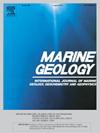Signature of off-axis hydrothermal sulfide mineralization at 23.19°S of Central Indian Ridge: Insights from mineralogy, geochemistry, geochronology and near-seabed AUV survey
IF 2.2
3区 地球科学
Q2 GEOSCIENCES, MULTIDISCIPLINARY
引用次数: 0
Abstract
Seafloor hydrothermal systems and associated sulfide mineralization have been reported along all types of mid-oceanic spreading ridges, island arcs, and back-arc settings. This study reports the occurrence of a distal ridge (∼35 km off-axis) hydrothermal mineralization zone from the slow-spreading Central Indian Ridge (23.19°S) of the Indian Ocean. The hydrothermal precipitates were recovered during dredging operations and mainly comprised of massive sulfides, sulfide breccias, and their secondary oxidized alteration products. The mineralogical quantification of pyrites (significant Cu enrichment, a strong negative correlation with Fe), and bulk sulfide geochemistry (concentrations and ratio of Ba, Co, and Pb) hint at a possible mixed type of mafic-ultramafic host-rock influence in the formation of sulfides. The 230Th/U chronological estimations of pyrites from massive sulfide and sulfide breccia suggest a wide range of hydrothermal activity from 144 ± 11 to 52 ± 7 ka. The AUV-assisted near sea floor sub-bottom profiling (SBP) and High-resolution Interferometric Synthetic Aperture Sonar (HISAS) images suggest that the study area is covered by thin layers of sediments with occasional exposure of hard rock outcrops. The reporting mineralization site stands out to be the most distant and one of the chronologically oldest hydrothermal mineralization zones within the Indian Ocean. The study provides insights into the broader geological processes at off-axis locations concerning the hydrothermal mineralization at slow-spreading ridges and indicates the possibility that such undiscovered buried hydrothermal fields may exist located far from the present-day ridge axis.

印度中脊23.19°S离轴热液硫化物矿化特征:矿物学、地球化学、年代学和近海底AUV测量
海底热液系统和相关的硫化物矿化在所有类型的洋中扩张脊、岛弧和弧后环境中都有报道。本研究报道了在缓慢扩张的印度洋中印度洋脊(23.19°S)上发现了远脊(距轴约35 km)热液矿化带。水热沉淀物是在疏浚过程中回收的,主要由块状硫化物、硫化角砾岩及其次生氧化蚀变产物组成。黄铁矿的矿物学定量(Cu富集显著,与Fe呈强负相关)和大量硫化物的地球化学特征(Ba、Co和Pb的浓度和比值)表明,硫化物的形成可能受到镁质-超镁质-寄主岩石的混合影响。块状硫化物和硫化物角砾岩中黄铁矿的230Th/U年代学估计表明,热液活动范围为144±11 ~ 52±7 ka。auv辅助近海底亚底剖面(SBP)和高分辨率干涉合成孔径声纳(HISAS)图像表明,研究区域被薄层沉积物覆盖,偶尔暴露出坚硬的岩石露头。报告的矿化地点是印度洋内最遥远和年代最古老的热液矿化带之一。该研究提供了关于缓慢扩张脊的热液矿化在离轴位置的更广泛的地质过程的见解,并表明这种未被发现的埋藏热液场可能存在于远离现今脊轴的位置。
本文章由计算机程序翻译,如有差异,请以英文原文为准。
求助全文
约1分钟内获得全文
求助全文
来源期刊

Marine Geology
地学-地球科学综合
CiteScore
6.10
自引率
6.90%
发文量
175
审稿时长
21.9 weeks
期刊介绍:
Marine Geology is the premier international journal on marine geological processes in the broadest sense. We seek papers that are comprehensive, interdisciplinary and synthetic that will be lasting contributions to the field. Although most papers are based on regional studies, they must demonstrate new findings of international significance. We accept papers on subjects as diverse as seafloor hydrothermal systems, beach dynamics, early diagenesis, microbiological studies in sediments, palaeoclimate studies and geophysical studies of the seabed. We encourage papers that address emerging new fields, for example the influence of anthropogenic processes on coastal/marine geology and coastal/marine geoarchaeology. We insist that the papers are concerned with the marine realm and that they deal with geology: with rocks, sediments, and physical and chemical processes affecting them. Papers should address scientific hypotheses: highly descriptive data compilations or papers that deal only with marine management and risk assessment should be submitted to other journals. Papers on laboratory or modelling studies must demonstrate direct relevance to marine processes or deposits. The primary criteria for acceptance of papers is that the science is of high quality, novel, significant, and of broad international interest.
 求助内容:
求助内容: 应助结果提醒方式:
应助结果提醒方式:


